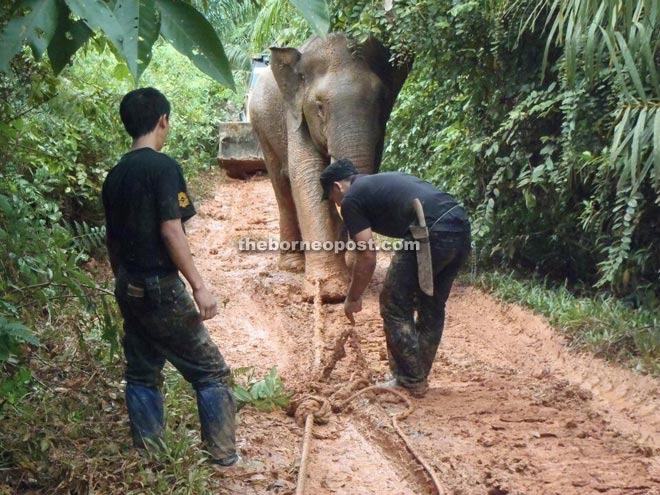
Sabah Wildlife Department’s wildlife rescue staff translocating the elephant.
KOTA KINABALU: Sabah Wildlife Department (SWD) director William Baya yesterday denied allegations that the department’s wildlife rescue staff were abusive towards a wild elephant while carrying out a translocation operation.
“Let me assure you sir that in no way were the Sabah Wildlife Department/Wildlife Rescue personnel trying to abuse this wild elephant that was being translocated from a human-elephant conflict area to a protected forest reserve some 200km away.
“In this particular case my team was up against a rogue bull elephant that was exceptionally dangerous and was a huge threat to the lives of the rescue personnel as well as the villagers,” he explained.
“That was why my staff took extra precaution and care measures. In normal cases when the wild elephants are more cooperative, the translocation process is done more smoothly and with less risk,” said William
He added that the photographs of the alleged ‘brutal treatment’ of the elephants took place in Kampung Bauto, Telupid following a major human-elephant conflict that was reported to his department in February, last year.
SWD assistant director and Wildlife Rescue Unit manager Dr Sen Nathan explained that wildlife rescue staff had to risk their own lives and limbs each time they carried out elephant translocation.
“Elephant translocation is a very dangerous activity and it will be conducted when there is no other way to chase or control the elephant away from the area and has to be done as soon as possible to stop from doing more damage and to protect the villagers,” said Dr Sen.
He said that elephants had different temperaments and that in the Kampung Bauto case, members from the wildlife rescue team were facing a very dangerous and very wild elephant.
He then explained the process involved in elephant translocation.
“Elephant translocation involves tracking of the elephant, followed by darting tranquillizers, restraining, transportation and release to a safe site.
“After the first tranquilization during capture, the elephant will not be sedated again after that up until the release. Hence, the transfer of animal into translocation crate, transfer to the release site and the release will be conducted with the elephant wide awake.”
He said that they avoided tranquilizing the elephant again as this would have severe risk of the animal dying.
“During this whole process the safety of the personnel involved is a priority as well as of the elephant,” added Dr Sen
“As seen in the photo grab of the video the ‘poking’ occurred during the transfer of the elephant into the translocation crate for release which was carried out on the same day of release itself.
“Different elephant will react differently towards this process. If the elephant is cooperative, it will move on its own while the chains were pulled.
“This process has to be done with care because if the elephant walked toward the wrong direction, it might end up outside the crate and the crate may fall onto the personnel at the site.
“To sum up, poking using the blunt end metal pole is to divert the animal’s attention so they walk in the right direction. It is not done to hurt the animal. This was never our intention.
“Let me also assure you that this elephant was not hurt in anyway,” he concluded.
